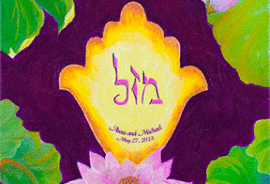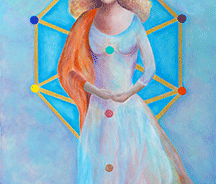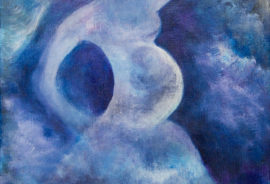The Megillah and the Four Worlds – written by Leon Olenick and grandson, Steven Sam Crist
On Purim, we dress up in costumes, we wear masks, we give tzadakah and we’re told to get so “high”, or drunk, that we can’t tell the difference between blessing Mordecai and cursing Haman. The kavanah or intention, of the masks and costumes is to celebrate the holiday for the festival that it is, mimicking and acting out the roles of the characters of the story and stretching past our usual comfort zones. However, as any actor will tell you, it is not enough to mimic roles- one must understand the spirit of the character that one is trying to embody. As the intricacies of the story of Purim are unraveled, and the characters revealed, we ought to look for traits of the characters that may be in ourselves– to look at, and relate them to our own family‘s interactions, and the stories in our lives. Although this may be painful on some levels, if approached with good eyes and opened hearts, it can release us to be able to celebrate another victory from tyranny. This victory is our own.
We are taught on Purim to give tzadekah- we are taught to give. In looking into ourselves, we must also be vulnerable – we must open our hearts and our minds. In doing so, we may see not only ourselves, but our families and communities with clarity and honesty. This is how we must govern ourselves- with clarity and a willingness to release the “klepot”, the hard coverings that block us from the truth of the nature of the individual and collective aspects of our family systems, just as Ahashveros, Vashti, Ester, Mordecai, and Hamon came to see their family with clarity. We can achieve this by looking at the human condition through the lens of the four worlds that we all live in: doing, feeling, thinking, and being. If we expand our concept of the world to something of a conglomeration of the Four Worlds, we can focus on what world(s) we often find ourself in, and from that point, find ways to expand in the world(s) that we have receded from. Similarly, if we examine the characters we encounter in the Purim story, we find that we may relate to a certain character more than any other.
DOING
Ahashveros
In any family, just as in any story, we often find people who fit squarely into character archetypes: the obedient son, the rebellious daughter, the overbearing father, etc. Ahashveros was power hungry, acting out on whatever whim he saw fit, and exploiting, mistreating, and abusing those under him, especially women. He had power, but constantly desired and demanded more, almost to a point where one might consider him fearful of losing his power. Ahashveros is the overbearing, workaholic father- his deficits of character are of a spiritual and intellectual nature. He resides solely in the world of Doing, and as such commands a thirst for action and control, ultimately driving him to atrocities against the Jewish people, and his eventual overthrow.
Many of us have had an Ahashveros in their lives- the father that could never be satisfied with his lot. What drove him to a predisposition for a deep hunger for power, and a deep disdain for those he considered beneath him? We must also note that Ahashveros was king of the Persian Empire; do we see similar traits in our leaders today?
VASHTI
When Vashti was summoned to the court of Ahashveros, she refuses to degrade herself. The king requests that she come in only the royal crown, so that his guests could admire and be entertained by her beauty. As a queen, she had power, but also a deep sense of dignity- in overcoming the obstacle of being objectified, she made herself into both a hero, and, through her execution, a martyr.
Vashti was willing to die for her beliefs, yet her actions later place Ester in a position very similar to the late Queen’s. We all have obstacles to overcome in our lives- in the world of Doing, we are driven to take the actions necessary to push past the barriers that have been placed in front of us, regardless of consequence.
FEELING
Hamon
We like to think that in the world of feeling, we live in the world of the heart – in the world in which we communicate our emotions – the world in which love resides. The world of “feeling” places us squarely in the world of our emotional landscape. This landscape also has a shadow – when our emotions run amok and are filtered by hatred and evil, we encounter the “Hamons” of the world. Hamon resided in a world of hate, resentment, and ambition. His goal was control- the wicked “other” in the family that wished only to have the world not only pay attention to him, but also listen and act on everything that he expressed, going to great lengths to make it so. When asked to honor another, he becomes resentful, even fearful, that it would undermine his own efforts- to the length that he would have the offender executed, and his people exterminated. Hamon was ruled by his negative hate-filled emotions, and as such, was destroyed by them, also.
We all know someone who is easily pushed to emotional extremes- raging, irrational anger, jealousy, love, sadness- and while there are often relics of the past to push these people to a space of hypersensitivity (or insensitivity, as it may be), if given proper guidance, they can come out of a binding world of Feeling, and grow into a more balanced person. Hamon was obviously not going to receive counseling from Ahashveros- and certainly not Mordecai. Through Hamon’s anger, greed, and reactive nature, he not only contributed directly to the deaths of those who battled on the day of his decree to exterminate the Jews, but to his own eventual demise, as well. It is easy to be ruled by one’s feelings- yet, when we take time, and reflect on what drives us to such emotional extremes, we can take not of that which is in us that is torturing us so, and heal in such a way that we can expand into fully developed version of ourselves- one that resides in all four worlds of peace simultaneously.
THINKING
Mordecai
Mordecai is the archtypical, wisened grandfather- he meditates and considers, he offers advice and guidance, but does not often take direct action. His penchant for listening and making measured decisions make him a hero in the Megilla. Ester, saving the king puts him in the King’s favor, as does his role in raising the King’s new Queen. We also see how Mordecai’s good nature follows him. Haman has plots that would result in the execution of Mordecai, even going so far as to erect gallows. Yet, when the time comes for Haman to initiate his plans, Mordecai is instead honored, and brought around town dressed in the likeness of the King.
Mordecai resides soundly in the world of thinking. He takes vigil by the palace gates, allowing him to overhear and track the proceedings of the palace in which Ester resides, ensuring her safety. Though he was concerned for the girl whom he raised, he always kept his mind fixed on the big picture- the preservation of peace and the community. By acting on plans well-considered, he is able to find favor in the King, not only for himself, but for his people, as well. However, while existing in the world of Thinking can lend one to the habit of seeing the big picture, how was Mordecai’s personal life affected by his character? Though he was concerned, he may have also been overly analytical, retracting from the community that he worked to preserve. While his commitment to his self-proclaimed duty to protect Ester and his community may have saved it, is it possible that he could have played a greater role within his community, while still yielding the same results that saved it?
BEING
Ester
Ester resides squarely in the world of being. She is the unambitiously wise young woman who delves deep into the underlying mechanics of the spiritual world, more so than the artificial palace life that has been set out before her. When faced with the extermination of her people, her call for fast comes from a recognition that when corporeal needs are suspended, the needs of the neshama reveal themselves. We see this immediately when she is presented to Ahashveros. Her decline of the beauty treatments that were offered to her shows that she is aware of her beauty, even to the point of fearing that it would be the deciding factor in being chosen as the new Queen.
When faced with a problem, many people panic and immediately consider everything bad that could follow. Conflict and misfortune often pull people firmly into the world of thinking, wildly unbalancing their hearts, and inevitably sabotaging any future effort needed to amend the situation. In spite of the situation and sacrifices Ester must make, she is still able to go into herself with meditation and prayer, enough so that she is able to preserve her dignity and self-respect, keeping her in touch with the Holy One. When faced with her mitzrayim and her moment of hardship, she enters a state of being deep enough that she can clearly see the actions that she must take to prevent catastrophe and misery for her people.
As we prepare to celebrate the bravery of Ester, we ought to consider the sacrifices made by those in the Megila, and the efforts put forth to overcome each individual characters’ penchant for preferring one world over another. We all live in all four worlds at once, at all times- however, it is easy to slip into a pattern where one would find oneself unbalanced, and in need to expand to the other worlds. Just as Mordecai was drawn toward the world of thinking, so was Ester drawn toward the world of Being- and just as Ester had to expand herself more fully into the world of Doing, so too did Mordecai have to expand his heart more fully into the world of Feeling- it was this expansion of self that allowed them to face the difficulties set before them. Though it may take some amount of struggle or restraint to round oneself into the worlds that we are not closest to, when we are able to find a balance between the four worlds, we are released- we have harmony- we are able to remove our masks, and can then act in the world, in our communities, and in our families, from a place of peace.








A new and important look at the Purim story – good insights, good writing and captivating story. I’m sharing this with my friends.
Very true and beautiful Yasher Ko’ach
Love this – wonderful intergenerational collaboration!
appreciate the complexity revealed in this insightful presentation. will happily share with family & friends